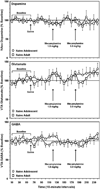Adolescent rats are resistant to adaptations in excitatory and inhibitory mechanisms that modulate mesolimbic dopamine during nicotine withdrawal
- PMID: 22905672
- PMCID: PMC3472122
- DOI: 10.1111/j.1471-4159.2012.07926.x
Adolescent rats are resistant to adaptations in excitatory and inhibitory mechanisms that modulate mesolimbic dopamine during nicotine withdrawal
Abstract
Adolescent smokers report enhanced positive responses to tobacco and fewer negative effects of withdrawal from this drug than adults, and this is believed to propel higher tobacco use during adolescence. Differential dopaminergic responses to nicotine are thought to underlie these age-related effects, as adolescent rats experience lower withdrawal-related deficits in nucleus accumbens (NAcc) dopamine versus adults. This study examined whether age differences in NAcc dopamine during withdrawal are mediated by excitatory or inhibitory transmission in the ventral tegmental area (VTA) dopamine cell body region. In vivo microdialysis was used to monitor extracellular levels of glutamate and gamma-aminobutyric acid (GABA) in the VTA of adolescent and adult rats experiencing nicotine withdrawal. In adults, nicotine withdrawal produced decreases in VTA glutamate levels (44% decrease) and increases in VTA GABA levels (38% increase). In contrast, adolescents did not exhibit changes in either of these measures. Naïve controls of both ages did not display changes in NAcc dopamine, VTA glutamate, or VTA GABA following mecamylamine. These results indicate that adolescents display resistance to withdrawal-related neurochemical processes that inhibit mesolimbic dopamine function in adults experiencing nicotine withdrawal. Our findings provide a potential mechanism involving VTA amino acid neurotransmission that modulates age differences during withdrawal.
© 2012 The Authors Journal of Neurochemistry © 2012 International Society for Neurochemistry.
Conflict of interest statement
The authors do not have any conflicts of interest to report.
Figures








Similar articles
-
Nicotine withdrawal produces a decrease in extracellular levels of dopamine in the nucleus accumbens that is lower in adolescent versus adult male rats.Synapse. 2010 Feb;64(2):136-45. doi: 10.1002/syn.20713. Synapse. 2010. PMID: 19771590 Free PMC article.
-
Region-specific effects of N,N'-dodecane-1,12-diyl-bis-3-picolinium dibromide on nicotine-induced increase in extracellular dopamine in vivo.Br J Pharmacol. 2008 Feb;153(4):792-804. doi: 10.1038/sj.bjp.0707612. Epub 2007 Dec 3. Br J Pharmacol. 2008. PMID: 18059317 Free PMC article.
-
Ethanol elevates accumbal dopamine levels via indirect activation of ventral tegmental nicotinic acetylcholine receptors.Eur J Pharmacol. 2003 Apr 25;467(1-3):85-93. doi: 10.1016/s0014-2999(03)01564-4. Eur J Pharmacol. 2003. PMID: 12706460
-
A psychobiological framework of the substrates that mediate nicotine use during adolescence.Neuropharmacology. 2009;56 Suppl 1(Suppl 1):263-78. doi: 10.1016/j.neuropharm.2008.07.039. Epub 2008 Aug 5. Neuropharmacology. 2009. PMID: 18723034 Free PMC article. Review.
-
The "stop" and "go" of nicotine dependence: role of GABA and glutamate.Cold Spring Harb Perspect Med. 2013 Jun 1;3(6):a012146. doi: 10.1101/cshperspect.a012146. Cold Spring Harb Perspect Med. 2013. PMID: 23732855 Free PMC article. Review.
Cited by
-
New mechanisms and perspectives in nicotine withdrawal.Neuropharmacology. 2015 Sep;96(Pt B):223-34. doi: 10.1016/j.neuropharm.2014.11.009. Epub 2014 Nov 26. Neuropharmacology. 2015. PMID: 25433149 Free PMC article. Review.
-
Reduced dopamine release in the nucleus accumbens core of adult rats following adolescent binge alcohol exposure: age and dose-dependent analysis.Psychopharmacology (Berl). 2015 Feb;232(4):777-784. doi: 10.1007/s00213-014-3712-1. Epub 2014 Aug 14. Psychopharmacology (Berl). 2015. PMID: 25116483 Free PMC article.
-
Adolescent oxycodone exposure inhibits withdrawal-induced expression of genes associated with the dopamine transmission.Addict Biol. 2021 Jul;26(4):e12994. doi: 10.1111/adb.12994. Epub 2020 Dec 15. Addict Biol. 2021. PMID: 33325096 Free PMC article.
-
Neurochemical and Behavioral Characterization after Acute and Repeated Exposure to Novel Synthetic Cannabinoid Agonist 5-MDMB-PICA.Brain Sci. 2020 Dec 18;10(12):1011. doi: 10.3390/brainsci10121011. Brain Sci. 2020. PMID: 33353194 Free PMC article.
-
Amino acid systems in the interpeduncular nucleus are altered in a sex-dependent manner during nicotine withdrawal.J Neurosci Res. 2022 Aug;100(8):1573-1584. doi: 10.1002/jnr.24826. Epub 2021 Mar 22. J Neurosci Res. 2022. PMID: 33751631 Free PMC article.
References
-
- Biala G, Budzyska B, Kruk M. Naloxone precipitates nicotine abstinence syndrome and attenuates nicotine-induced antinociception in mice. Pharmacology Rep. 2005;57:755–760. - PubMed
-
- Bonci A, Williams JT. A common mechanism mediates long-term changes in synaptic transmission after chronic cocaine and morphine. Neuron. 1996;16:631–639. - PubMed
-
- Carboni E, Bortone L, Giua C, Di Chiara G. Dissociation of physical abstinence signs from changes in extracellular dopamine in the nucleus accumbens and in the prefrontal cortex of nicotine dependent rats. Drug and Alc Dep. 2000;58:93–102. - PubMed
Publication types
MeSH terms
Substances
Grants and funding
- 5G12RR008124/RR/NCRR NIH HHS/United States
- G12 RR008124/RR/NCRR NIH HHS/United States
- T32 MH018882/MH/NIMH NIH HHS/United States
- F31-DA021133/DA/NIDA NIH HHS/United States
- R25 DA033613/DA/NIDA NIH HHS/United States
- R01 DA021274/DA/NIDA NIH HHS/United States
- F32 DA029994/DA/NIDA NIH HHS/United States
- T32-MH018882/MH/NIMH NIH HHS/United States
- P01 DA017259/DA/NIDA NIH HHS/United States
- F31 DA021133/DA/NIDA NIH HHS/United States
- P01-DA017259/DA/NIDA NIH HHS/United States
- R01-DA021274/DA/NIDA NIH HHS/United States
LinkOut - more resources
Full Text Sources

